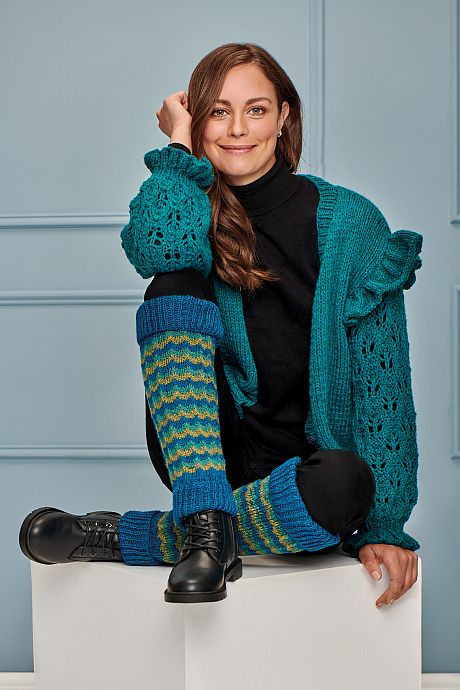Learn the secrets to make Charmaine Fletcher’s legwarmers like a pro!
Let’s Knit designer Charmaine Fletcher is well known for her fantastic patterns and they are all finished to perfection. The pattern for these brilliant legwarmers can be found in the January edition of Let’s Knit magazine (issue 192). Here are some additional words of wisdom from Charmaine on how you elevate your make into a technical marvel.

How do I prevent a jog when knitting stripes?
In helical work (working in a spiral), when knitting stripes there is always a ‘jog’ because where the colours change from one to another, the lines of stripes don’t meet. This Bargello-style pattern makes a feature of the ‘jog’ to create the waves element. However, other ‘jog’ minimising elements have also been incorporated. First, do not join into the round. Work the recommended cast-on and continued cast-on, then weave in the cast-on yarn tail at the end, replicating, the overlapping stitches. This evens-up the lower edge without a ‘step’. Secondly, on the knit rows, between the slipped stitch ones, the ‘jog’ returns. To prevent it, knit one below into the first stitch of pattern row four (row 39 in the sequence). This pulls-up the stripe to even out the rows where otherwise, they would be misaligned.
How do I introduce a new colour?
Initially, this will be worked on pattern row one (Row 39) of Colour two (yellow), pattern row one (row 43) of Colour three (green). Before starting pattern row one, slip the last stitch from the right-hand needle to the left-hand needle purl-wise. Fold the new yarn colour (yellow or green as appropriate) so that it has a yarn tail of 20cm with the ball end, serving as the working yarn, on top (it will resemble a sideways ‘U)’. Slip it on to the right hand needle, then slip the last stitch back sandwiching the new yarn between the last and penultimate stitches. Work pattern row one until reaching the new yarn and last stitch. Apply the carrying yarn instructions but knit the looped new yarn and the old colour together as well. It forms an invisible (from the front) strong join. Repeat this with the next colour (green) when appropriate. At the end, weave in the loose yarn tails. Splitting the yarn and sewing in the ends for extra security.

Should I carry the yarn up the side?
Yes, carrying the yarn to each stripe repeat eliminates the need to sew in joins and creates a strong, neat finish as the knitting progresses. On pattern row one (35 of the sequence) carry the yarn on the final stitch (60, 70 or 80) on subsequent rows do so on the penultimate stitch. Repeat this as the colours change. Also, hold the auxiliary yarns together, and carry together. Work to the ‘carrying stitch’; insert the right-hand needle, into the stitch as to work a knit stitch, take the auxiliary yarn/s under the working yarn and over it. Take the auxiliary yarn/s around the tip anti-clockwise (under, around and over). Hold them there (its helpful to loop the strands out of the way over the left-hand needle) and, using the working yarn, knit into the stitch as normal, being careful not to draw the auxiliary yarn/s with the stitch. Gently pull the auxiliary yarns upwards and take the working yarn in front of them (near the right hand needle) to continue knitting. The working yarn will create a tiny holding stitch. It is important to ensure that the auxiliary yarns are behind the working yarn so that it is not trapped. Adjust the holding stitch to neaten and switch between auxiliary and working yarns as the colours change.
What cast off should I use?
Charmaine used the Stretchy rib cast-off. Here’s how to do it:
Start with a yarn forward, then k1. Using the left needle, lift the yarn forward over the stitch just knitted (one stitch on the needle). Bring the yarn to the front under the right needle tip, over and around it to the front (two stitches on the needle), p1, (three stitches on the needle). Using the left needle insert the tip left to right through the knit stitch and the yfwd and take both over the purl stitch (one stitch on the needle). Thereafter work as follows: * yfwd, k1, slip the first two stitches over the knit stitch (one stitch on the working needle), yrn, p1 (three stitches on the working needle), pass first two stitches over the remaining purl stitch (one stitch remaining on the working needle) **, repeat from * to ** to the end. To complete, insert the needle in the first cast-off stitch and cast-off as before, repeat with the second stitch. Weave-in and secure; trim.
“These legwarmers are not the same as ballet legwarmers that are tighter and higher with a closer fit. They have been designed to go over jeans, jeggings or leggings and as such, are supposed to be ruched. They can also be worn longer with the top cuff unfolded. The legwarmers can be made smaller still as long as the pattern rows are divisible by five and also by two for the rib: eg: 50, 40, 30 but not 55, 45 or 35.”
Let’s Knit Designer, Charmaine Fletcher
The January issue of Let’s Knit is out now!





_333_180_c1.png)
_333_180_c1.png)

_333_180_c1.png)
 Baby
Baby
 Toys
Toys
 Garments
Garments
 Crochet
Crochet
 Homewares
Homewares
 Dolls
Dolls



Share